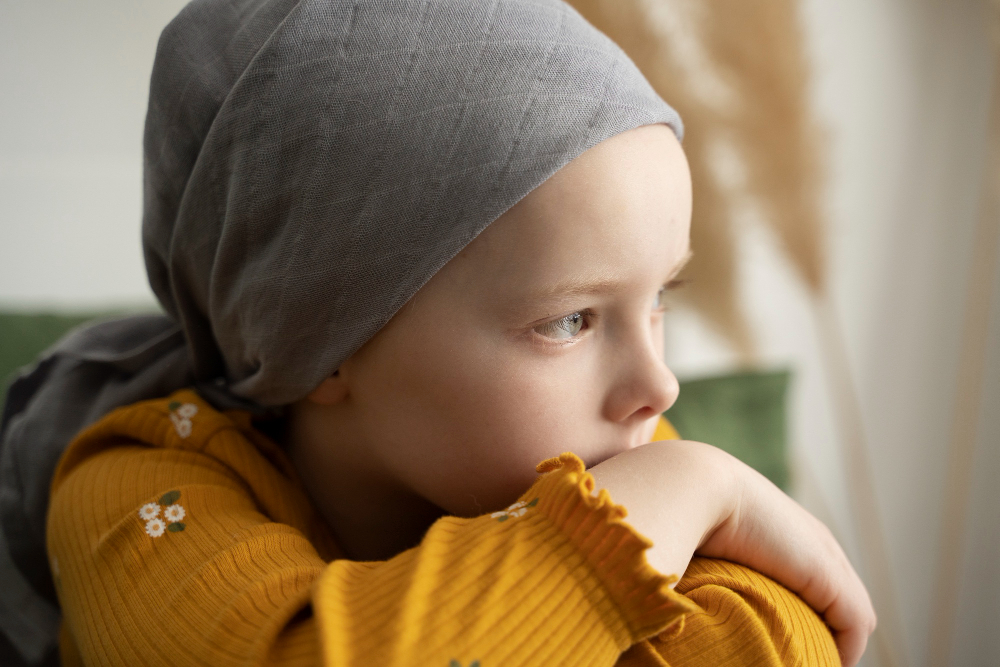What Is Childhood Leukaemia?
11 April 2023
What Is Childhood Leukaemia?
Leukaemia is a type of cancer that affects the blood-forming tissues of the body, and while it can affect individuals of all ages, some types are more commonly diagnosed in children. In Malaysia, leukaemia is more commonly diagnosed in children under the age of 14.
This type of cancer originates from blood cells, and typically involves cancer of the white blood cells in children. However, in rare instances, it can originate from other blood cell types.

Types of Leukaemia
There are different types of leukaemia, and they can be grouped based on the progression of the disease and the type of blood cell that is affected.
| Types of Leukaemia | Acute (The disease gets worse quickly) | Chronic (The disease gets worse slowly) |
|---|---|---|
| Myeloid (The disease starts in myeloid cells) | Acute Myeloid Leukaemia (AML) Common in children and adults | Chronic Myeloid Leukaemia (CML) More common in adults |
| Lymphoid (The disease starts in lymphoid cells) | Acute Lymphoid Leukaemia (ALL) More common in children | Chronic Lymphoid Leukaemia (CLL) More common in adults |
The terms myeloid and lymphoid refer to the types of blood cells that are affected. Myeloid cells are cells that come from the bone marrow, while lymphoid cells are cells associated with the lymphatic system.
With regards to classification based on the rate of cancer progression, acute leukaemia progresses rapidly, while chronic leukaemia progresses at a slower rate.
Signs and Symptoms of Leukaemia
- Prolonged unexplained fever
- Swollen lymph nodes (neck, underarm, groin)
- Unusual bleeding and bruising (red spots caused by bleeding under the skin)
- Unexplained tiredness
- Headache or dizziness
- Pale skin
- Swollen belly
- Joint or bone pain
- Frequent infections
How Is Childhood Leukaemia Diagnosed?
- If your child exhibits symptoms that could indicate leukaemia, inform your local doctor or regular pediatrician. They will conduct a comprehensive assessment of your child's history, perform a physical examination, and order blood tests to help determine if your child has leukaemia.
- To confirm the diagnosis, a paediatric oncologist will generally perform a bone marrow aspiration and biopsy. This involves taking a small amount of fluid from the pelvic bone through a needle.
What Are the Treatments for Childhood Leukaemia?
-
Chemotherapy
A powerful combination of medicines is administered to the body through intravenous injection or oral intake to eliminate cancer cells and prevent them from multiplying rapidly.
-
Stem Cell Transplant
In some cases of leukaemia, it may be necessary to replace the blood-forming stem cells in the bone marrow with new ones from a donor. This procedure can involve using either blood or bone marrow. However, it is important to note that not all leukaemia cases require a stem cell transplant as part of the treatment plan.
-
Supportive Care and Follow-Up
Other treatments to support the patient's needs include, but are not limited to, blood transfusions, antimicrobial treatment for infections, medication for pain control, and social, emotional, and mental health support if needed.
-
Clinical Trials
New therapies from clinical trials that can be added to existing chemotherapy regimens or used as a replacement for them in the treatment of leukaemia.
-
Palliative Care
In cases where children have more complicated and long-term illnesses, it is important to provide supportive and comforting care to help alleviate symptoms and improve their overall quality of life.
The choice of treatment for leukaemia should always be made with the guidance and advice of a doctor or paediatric oncologist. The treatment plan can vary depending on the type and progression of the disease, as well as the patient's overall health and individual needs.
Therefore, seeking medical attention and advice is essential to determine the most effective treatment approach for each individual case of leukaemia.
Conclusion
Leukaemia is a form of cancer that can impact individuals of all ages. However, early detection of leukaemia can lead to a higher chance of survival.
It is important to be aware of the signs and symptoms of leukaemia and promptly notify your local doctor or paediatrician when any of these symptoms become apparent.
To book an appointment now with a paediatrician, visit https://www.sunwaymedical.com/en/speciality/paediatric-haematology-oncology.






